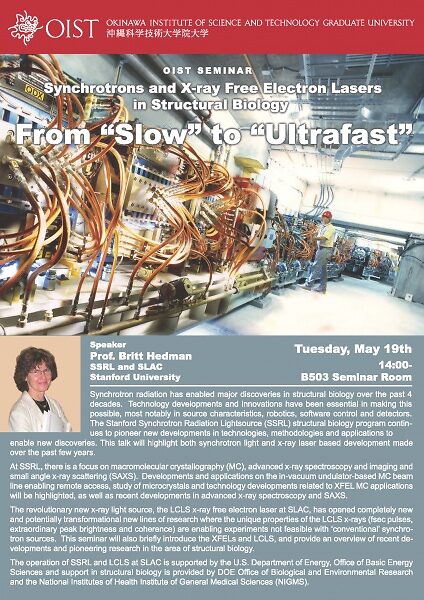OIST Seminar: Synchrotrons and X-ray Free Electron Lasers in Structural Biology – From “Slow” to “Ultrafast”

Date
Location
Description
Synchrotron radiation has enabled major discoveries in structural biology over the past 4 decades. Technology developments and innovations have been essential in making this possible, most notably in source characteristics, robotics, software control and detectors. The Stanford Synchrotron Radiation Lightsource (SSRL) structural biology program continues to pioneer new developments in technologies, methodologies and applications to enable new discoveries. This talk will highlight both synchrotron light and x-ray laser based development made over the past few years.
At SSRL, there is a focus on macromolecular crystallography (MC), advanced x-ray spectroscopy and imaging and small angle x-ray scattering (SAXS). Developments and applications on the in-vacuum undulator-based MC beam line enabling remote access, study of microcrystals and technology developments related to XFEL MC applications will be highlighted, as well as recent developments in advanced x-ray spectroscopy and SAXS.
The revolutionary new x-ray light source, the LCLS x-ray free electron laser at SLAC, has opened completely new and potentially transformational new lines of research where the unique properties of the LCLS x-rays (fsec pulses, extraordinary peak brightness and coherence) are enabling experiments not feasible with ‘conventional’ synchrotron sources. This seminar will also briefly introduce the XFELs and LCLS, and provide an overview of recent developments and pioneering research in the area of structural biology.
The operation of SSRL and LCLS at SLAC is supported by the U.S. Department of Energy, Office of Basic Energy Sciences and support in structural biology is provided by DOE Office of Biological and Environmental Research and the National Institutes of Health Institute of General Medical Sciences (NIGMS).
Attachments
Subscribe to the OIST Calendar: Right-click to download, then open in your calendar application.



